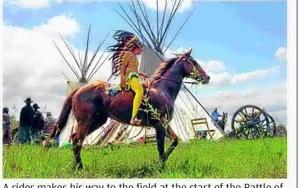BILLINGS — Facing the Native warriors, U.S. troops under Lt.
Col. George Armstrong Custer were quickly killed. Yet, the Battle of the Little Bighorn in 1876 erupted from yearslong tensions between the federal government and the Sioux, Northern Cheyenne and Arapaho tribes.

And for the Crow organizers of the reenactment that opened Friday, Custer's swift demise marks the culmination of year-round preparation — and a much deeper tale. "Not only are we telling the story of the battle, but we're telling the story of the horse nation, the horse people," Shawnee Real Bird said. "And then also the villagers.
The gatherers. The food-gatherers. So we go through all the different phases of what led up to the battle.
" Real Bird's family has put on the annual reenactment for decades just south of Crow Agency. Today it features a newer PA system and welcomes hundreds of attendees per show. Still, family members said they remain focused on telling the story just as it would have looked a century and a half ago.
And so do the reenactors from the Montana-based U.S. Cavalry School, who portray Custer's doomed forces and other U.
S. troops across the story narrated by Henry Real Bird. "They learn all the customs and courtesies of the military at that time," said Caleb Tappan, a first sergeant with the school, which intensively prepared the reenactors over a week.
Cavalrymen fired a cannon, and the reenactment began with introductions of both sides. As Henry Real Bird narrated — "poetry in .
















